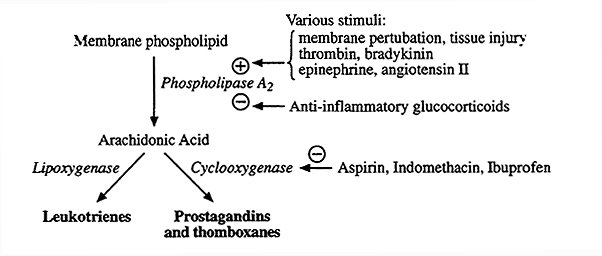
Arachidonic Acid Metabolism
General Information:
Prostaglandins:
All mammalian cells, except RBC's, produce prostaglandins and their related compounds, the prostacyclins, thromboxanes and leukotrienes (known collectively as eicosanoids since they are all C20 compounds, eicosa = 20).
The eicosanoids, like hormones, have profound physiological effects at very, very low concentrations.
Some of the physiological effects of Prostaglandins:
(1) The inflammatory response (rheumatoid arthritis).
(2) The production of pain and fever.
(3) The regulation of blood pressure.
(4) The induction of blood clotting.
(5) The control of several reproductive functions such as the induction of labor.
(6) The regulation of the sleep / wake cycle.
Protaglandin Synthesis:
They are synthesized via enzymes and react at G-protein linked receptors and are therefore intracellularly mediated by cAMP.
They are not transported in the blood but instead are produced and act in a local environment because they are chemically, biologically very unstable (short half-life).
Liberation of Arachidonic Acid and its Metabolism to Protaglandins (PG), Thromboxanes (TX)and Leukotrienes (LT)

Arachidonic Acid:
The most important protaglandin precursor is arachidonic acid.
Arachidonic acid is an essential fatty acid and is also synthesized from dietarily essential linoleic acid.
Essential Fatty Acids:
Linoleic, a-Linolenic and Arachidonic acids
Note: since arachidonic acid is synthesized from linoleic acid the nutritional requirement for arachidonic acid can be dispensed if there is adequate linoleic acid in the diet.
The Three Series of Eicosanoids and Their Biosynthetic Origins:
For PG and TX the # subscript denotes the number of double bonds outside the ring.
For LT the # subscript denotes the total number of double bonds in the compound.

Conversion of Arachidonic Acid to Series 2 PG's and TX's:
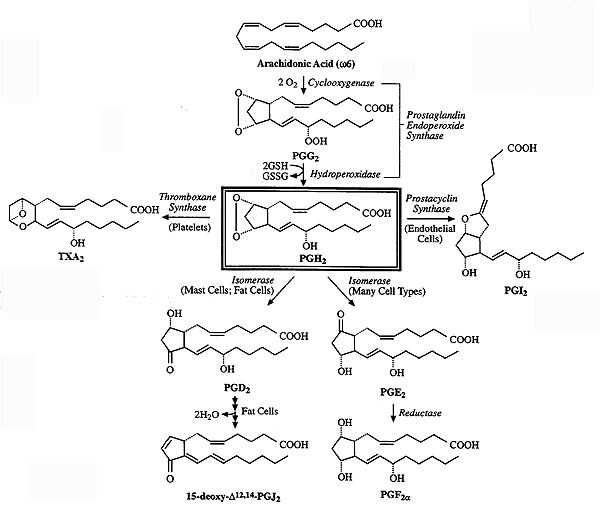
Prostaglandin Endoperoxide Synthase:
Cyclooxygenase Activity-catalyzes the addition of two molecules of O2 to arachidonic acid producing PGG2 (highly unstable)
Hydroperoxidase Activity- mediates a glutathione dependent rxn that converts the hydroperoxy- function of PGG2 to an OH group.
PGH2 is the immediate precursor of all series 2 PG's and TX's
Structure and Mechanism of Cyclooxygenase Inhibition by Aspirin :

Conversion of Arachidonic Acid to Series 4 Leukotrienes:
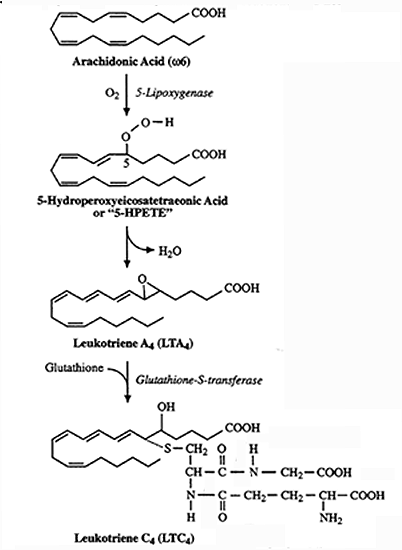
Biology of the Prostaglandins, Thromboxanes and Leukotrienes
A delicate balance between platelet aggregation/disaggregation and vessel constrcition/relaxation.
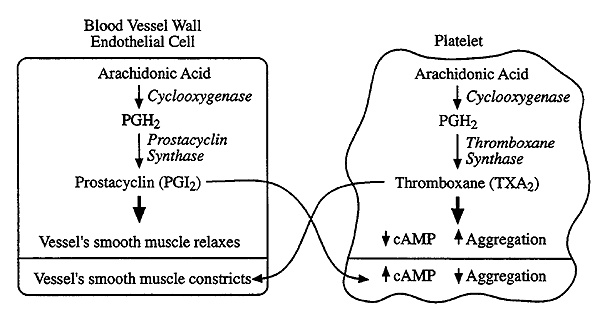
Low Dose Aspirin and Dietary w-3 Fatty Acids (Deep Cold Water Fish Oil)
Low Dose Aspirin: inhibits platelet cyclooxygenase to reduce the level of TXA2 compared to PGI2
Dietary w-3 Fatty Acids: leads to more PGI3 than TXA3
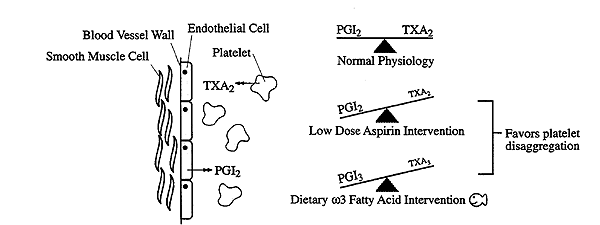
The ReproductiveSystem:
PG's have powerful effects on the reproductive system.
The best documented action of PG's in the female is stimulation of uterine smooth muscle.
Leukotrienes:
Are synthesized by a variety of white blood cells and are responsible for inflammatory and allergic reactions in lung, spleen, brain and heart
Peptidoleukotrienes: LTE4 and LTD4
Are recognized to be the components of the slow reacting substances of anaphylaxis (a violent and potenitially fatal allergic reaction)
Vioxx and Cyclooxygenase:
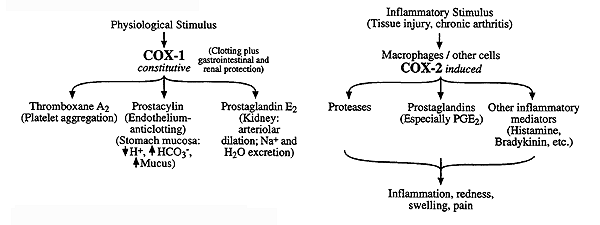
Cyclooxygenase (COX) exists as two isozymes, COX-1 and COX-2. The current hypothesis is that the therapeutic effects of drugs such as aspirin and Vioxx are due to the inhibition of COX-2 whereas the unwanted side-effects, such as the action on platelets, arise from inhibition of COX-1.
© Dr. Noel Sturm 2015